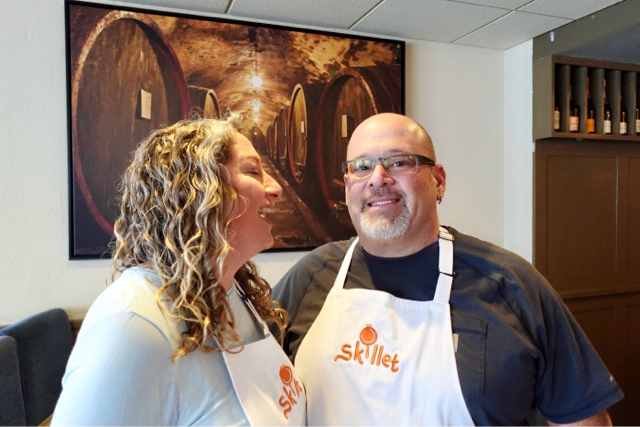
Myers+Chang At Home - Our Cookbook Crush
We are currently crushing on a cookbook we picked up during dinner one night in Boston.
Yes, you read that right. We picked up the cookbook during dinner.
Where we found the book
Myers + Chang is in Boston’s South End and is very much worth the 1-hour trek it takes to get there from our home in southern New Hampshire.
If the restaurant has a “chef’s table”, we’ll be there, so when on our first visit, we were seated at the counter on the other side of the open kitchen, we were very happy. We got to watch all the activity which normally stays behind the scenes.
As Keith and I perused the cocktail and beverage list, the sake menu popped with varieties we had never heard of, each with luscious descriptions such as, “plush”, “dreamy”, and “velvety”.
After our drinks were ordered, I looked around the vibrant restaurant and spotted a small counter behind the host stand holding several books. When books are displayed prominently in a public place, they call to me. I must look at every one. I pushed my chair back and stood up, pointing to the books in response to Keith’s quizzical look. When he spotted the shelf of books, that was all the explanation he needed. He knows me so well.
The Author
Joanne Chang is the successful entrepreneur behind Flour bakeries. She won the James Beard Award for Outstanding Baker, has numerous awards and accolades and has authored numerous cookbooks.
These bright and beautiful cookbooks were the ones that called to me from across the entire restaurant.
I first grabbed Flour, A Baker’s Collection of Spectacular Recipes, because, just LOOK AT THAT COVER!
She beat Bobby Flay in Throwdown with Bobby Flay with her sticky buns and they are amazing.
Her Sticky Sticky Bun recipe is a favorite with patrons of Flour.
We’ve been to both of the Flour bakeries in Boston for breakfast or a cupcake, and we highly recommend stopping in for a treat when you are in Boston, or to either of the 2 Flours in Cambridge as well.

I rejoined Keith at our seats with one of the other cookbooks from the shelf, MYERS + CHANG AT HOME: Recipes from the Beloved Boston Eatery. Perfect.
The photography by Kristin Teig is drool-worthy; showcasing some not-so-composed dishes with drips on the table and messy utensils captured in a casual way that evoked feelings of a family dinner filled with laughter and passed dishes. It reminds me of the style of photography we loved from Trejos Tacos.
Teig is an accomplished photographer with an extensive portfolio. Her clients include Google, Goop, King Arthur Baking, Travel & Leisure and more.
When the cookbook came out, the co-author was Karen Akunowicz, Myers + Chang Executive Chef and while she was in the role, Akunowicz was named James Beard Foundation Award winner for Best Chef: Northeast. She has since left and now owns 2 other restaurants, one having recently opened in Logan airport.
As we perused the menu, Keith would mention a dish that sounded good and I would look to see if it was in the cookbook.
The Cookbook Experience
I love how the Introduction of the cookbook contains many how-tos. The How to Shop in an Asian Grocery Store lasts several pages and provides numerous tips for selecting items needed for the recipes that follow, such as fish sauce, galangal, mirin, and rice.
The Introduction also contained a segment on How to Equip Your Kitchen. From a bamboo steamer to a rice-cooker, to tongs and a wok, this section goes deep into detail on the tools and appliances recommended to make the Myers + Chang recipes at home.
How to Cook Rice, How to Velvet, How to Wok, How to Shape Dumplings and How to Use Chopsticks were thorough segments included in the Introduction, but could have used some photos in my opinion, especially the dumpling section. Even though we have taken a dumpling class, seeing the steps and the finished result of folded dumpling shapes is critical for our novice level of expertise.
How to Eat Chinese Food is the last segment in the introduction and the “how” is complemented nicely by the “why”, which I really appreciate.
“The most important thing to remember is that stir-fries are meant to be eaten with rice…These dishes are strongly flavored assuming that you’ll take a small bite of saucy pork or chicken along with a small bite of unseasoned rice to create a balanced bite.”Joanne Chang + Karen Akunowicz
Tweet
I rejoined Keith at our seats with one of the other cookbooks from the shelf, MYERS + CHANG AT HOME: Recipes from the Beloved Boston Eatery. Perfect.
The photography by Kristin Teig is drool-worthy; showcasing some not-so-composed dishes with drips on the table and messy utensils captured in a casual way that evoked feelings of a family dinner filled with laughter and passed dishes. The style reminds me of one of our other cookbook crushes, Trejo’s Tacos.
Teig is an accomplished photographer with an extensive portfolio. Her clients include Google, Goop, King Arthur Baking, Travel & Leisure and more.
When the cookbook came out, the co-author was Karen Akunowicz, Myers + Chang Executive Chef and while she was in the role, Akunowicz was named James Beard Foundation Award winner for Best Chef: Northeast. She has since left and now owns 2 other restaurants, one having recently opened in Logan airport.
As we perused the menu, Keith would mention a dish that sounded good and I would look to see if it was in the cookbook.
I love how the Introduction of the cookbook contains many how-tos. The How to Shop in an Asian Grocery Store lasts several pages and provides numerous tips for selecting items needed for the recipes that follow, such as fish sauce, galangal, mirin, and rice.
The Introduction also contained a segment on How to Equip Your Kitchen. From a bamboo steamer to a rice-cooker, to tongs and a wok, this section goes deep into detail on the tools and appliances recommended to make the Myers + Chang recipes at home.
How to Cook Rice, How to Velvet, How to Wok, How to Shape Dumplings and How to Use Chopsticks were thorough segments included in the Introduction, but could have used some photos in my opinion, especially the dumpling section. Even though we have taken a dumpling class, seeing the steps and the finished result of folded dumpling shapes is critical for our novice level of expertise.
How to Eat Chinese Food is the last segment in the introduction and the “how” is complemented nicely by the “why”, which I really appreciate.
The section after the Introduction is Dum Sum. Not every recipe has a photo, which disappoints me a bit because Teig’s photography is so gorgeous, I would have liked to see these recipes come to life on the pages.
Other sections include Dumplings, Noodles, Wok, Salads and more. It made me happy to see that the recipe for Braised Short Rib Dumpling with Sichuan Chili Oil came complete with 6 photos showing step by step how to stuff and fold the dumplings properly.
One of the things most enjoyable about this cookbook is the introduction to the recipes. Sometimes it is a story, other times it serves as an explainer to the ingredients or the method. The writing style is never dull. You don’t have to even try to make the recipe. You could simply read these sections to educate yourself.
Keith has made a few recipes from the book, including the Thai Basil Chimichurri which we put on steak and loved. The recipe is short and the introductory paragraph includes a few serving suggestions.
Overall
We highly recommend this cookbook if you like Asian-Fusion and/or Taiwanese food. The pictures alone will convince you and if you are ever in the Boston area, make sure to make reservations to check out the restaurant.
Before our meal was up, we had ordered a copy to ship to the house. When dinner was served, I put the book down, and picked up my fork to enjoy every bite of my meal, no longer dreaming about the luscious and saucy dishes I saw in 2D between the pages. but planning how we could now make them at home.
Now, if only they would offer cooking classes.

